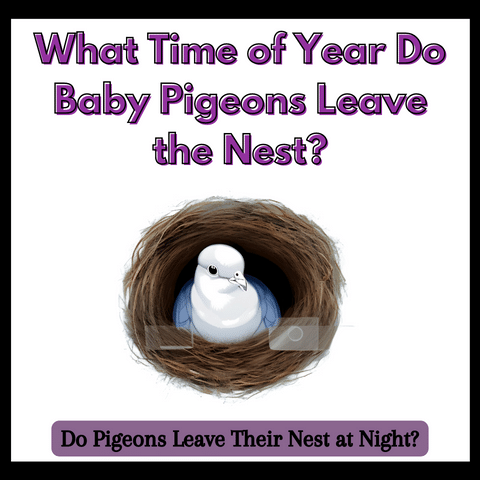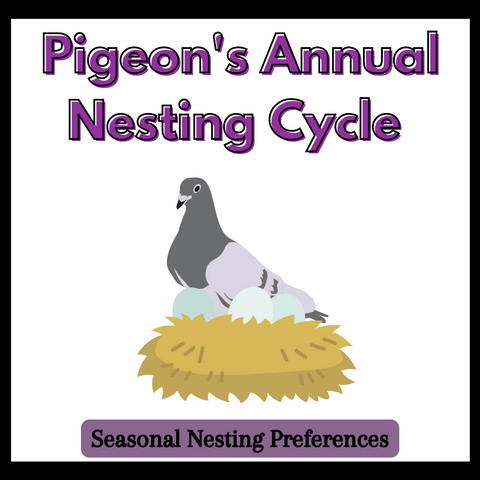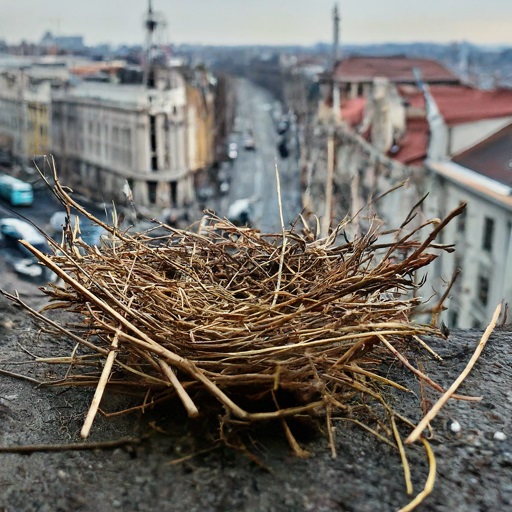Where Do Pigeons Nest? Exploring Pigeons Nesting Behaviour
Undoubtedly, pigeons are often overlooked as common urban Birds. Still, they tend to carry very intriguing & fascinating nesting habits that typically depend upon the seasons and their natural habitat. Therefore, if you want to know ‘where pigeons nest,’ this article is for you. In this article, you will understand where pigeon nests are and the habitat of their subspecies.
In this article, I will help you learn where pigeons’ nests come from in winter, bronze wing pigeons’ nests, and rock pigeons’ nests. Later, we will also quickly examine where pigeons nest in the wild. Therefore, if you want to learn their intriguing habits, nesting in the wild, and the nesting preferences of bronze wing pigeon & rock pigeon adaptability, read this article thoroughly. Let’s first begin with knowing ‘where pigeons nest in winter.’
Where Do Pigeons Nest In Winter?

During the winter, pigeons may seek out warmer & more protected areas to nest. They may choose locations such as attics, barns, or other buildings with sufficient warmth & shelter. Pigeons are known to form communal roosts where multiple birds gather together, which can provide additional warmth during the colder months.
You should also know that pigeons exhibit specific nesting behavior that will differ from other times of the year. Since pigeons are known to adapt their nesting habitats to survive the cold & harsh conditions of winter, they will actively seek out sheltered locations that can protect themselves from inclement weather.
A study conducted by the national society found that pigeons are known to select elevated spots like window sills and buildings for their winter nest. This behavior also helps them get ultimate protection against ground level and ensures short better insulation against the cold. Consider the table below if you want to know the difference in pigeon nesting behavior in winter and other seasons.
| Season | Nesting Behaviors |
| Winter | Elevated spots like building ledges, windowsills, etc. |
| Spring/Summer | Trees, dense shrubs, building crevices, rooftops, etc. |
| Fall | Similar to spring/summer nesting behaviors |
After knowing a quick comparison of pigeon nesting behavior in winter and other seasons, you should know how to identify them. If you are a bird watcher or bird enthusiast like me, watching them in the winter season can be an exciting activity. Below, I’m sharing a few tips to help you find their nest in the winter.
- Look For Elevated Locations: Since pigeons always use high places to build their nest during winter, you should consider checking buildings, bridges, & other structures for nests on ledgers, windowsills, or roof edges.
- Observe Pigeon Behaviour: If you are a bird watcher like me, you can observe their behavior during the daytime as pigeons often return to their nest. Keeping an eye on their movement pattern & following them will lead to their nesting spots.
- Look For Nesting Materials: You can also watch for nesting materials near potential nesting sites because the pigeons will use twigs, leaves, feathers & other materials to construct their nest.
- Listen For Cooing Sounds: Pigeons are undoubtedly known for their distinctive cooing sounds. So, follow the sound to locate the nesting spots as well.
- Seek Expert Advice: You can also consider consulting a local bird-watching group or experienced birders who will provide valuable insight into specific pigeon nesting locations in your area during winter.
Where Do Pigeons Nest In The Wild?
Pigeons typically nest in areas that provide themselves safety & resources for breeding & raising their young broods. This kind includes trees with dense foliage, cliffs and rocky ledges in natural habitats, caves, and crevices in rocky areas. Pigeons have been frequently observed building nests in tree cavities or on/in sturdy tree branches, especially in forested areas.
Their favorite tree tends to be deciduous trees with dense foliage as they provide ultimate protection from ground predations, avian predators, and climate elements. Other than this, if the pigeons are in their natural habitat, near cliffs or Rocky ledges, they will not hesitate to build a nest on it. Also, caves give them a good opportunity to build nests as they offer both security from predators and proximity to food sources.
Some pigeons have also been frequently observed nesting in caves and crevices in rocky areas, for example, African wood pigeons. Even though pigeons have adapted well to urban environments, they still can survive better in their natural habitats, especially in the wild. Since pigeons can have a wide range of habitats where they nest, below, I am giving you & in-depth comparisons of nesting locations between domesticated & wild pigeons.
| Environment | Domesticated Pigeons | Wild Pigeons |
| Urban Areas | Buildings, bridges, & other structures | Rocky cliffs, caves, & tree hollows |
| Rural & Forest Areas | Barns, sheds, & abandoned structures | Trees, dense shrubs, & forest canopies |
| Coastal Regions | Rooftops & seaside structures | Cliffs, rocky coastlines, & sand dunes |
After learning the difference between domesticated & wild pigeons, you need to pay attention to the factors that influence the nesting preference of wild ones. If you consider all the factors, you will be better equipped to spot any specific pigeon species in the wild & understand why they choose a specific location for their nest.
- Protection From Predators: As I told you earlier, pigeons often consider protection from predators when it comes to choosing the perfect nesting site. Since Rocky Cliff & tree hollows provide natural barriers against potential threats like birds of prey, snakes & mammals, pigeons often select those spots for nesting.
- Accessibility & Availability: Pigeons always like to choose nesting locations that can easily be accessed & tend to be readily available. They will often choose areas with suitable perching spots & abandoned nesting materials. They will also watch out for reliable food sources near their nesting area. It’s not uncommon for them to nest near close proximity to feeding grounds like agricultural fields or areas with abundant vegetation.
- Environmental Conditions: Another thing that you need to consider is the environmental conditions. Since pigeons adapt their nesting preferences to the prevailing environmental conditions, they may look out for shelter during harsh weather. For nesting purposes, they select cooler areas in warmer climates or warmer areas in cooler climates and vice versa.
Where Do Bronze Wing Pigeons Nest?

In the wild, bronze-winged pigeons typically nest in dense vegetation, particularly in forested areas. You are most likely to find them building their nest in low shrubs, bushes, or tall grasses near water sources like streams or marshes. Their nest will appear Cup-shaped & constructed using a combination of grass, leaves, twigs, & other plant materials.
Also, you should know that bronze-wing pigeons tend to be very shy & elusive birds, known for their district appearance & behavior. Therefore, they will be highly cautious about selecting their nesting sites, which provide them security and camouflage from predators. They often go with dense vegetation that protects them from predators and helps them conceal their nest from potential threats.
A study by the Australian National University found that these pigeons show strong site fidelity, meaning they often return to the same nesting locations year after year. This behavior ensures a good level of consistency in their breeding success & survival. I’m mentioning a proper table below to understand pigeons’ nesting habits.
| Characteristics | Description |
| Species | Usually placed in the forks of branches or bushes, around 2-5 meters above ground. |
| Preferred Nesting Locations | Dense shrubs, trees with dense foliage, & vegetation near water sources |
| Nest Structure | Compact nests made of twigs, leaves, & grass |
| Nest Placement | It is usually placed in the forks of branches or bushes, around 2-5 meters above ground. |
| Breeding Season | Mainly between September & March |
To help you learn more in-depth about where bronze wing pigeons nest, below & mentioning its top five sites:
- Eucalyptus Trees: In particular, we have seen bronze-wing pigeons favoring eucalyptus trees for nesting purposes due to their dense foliage & ample shelter it provides.
- Acacia Scrubs: Sometimes pigeons also go with the acacia shrubs due to their dense & thorny vegetation, which is best for protection from predators.
- Riparian Vegetation: As discussed earlier, bronze-wing pigeons will be attracted towards areas near water bodies like rivers & streams. Therefore, riparian vegetation tends to provide them with suitable nesting spots for breeding.
- Forest Edges: It’s not uncommon to notice many pigeons flying around in the edges of forests, especially when there is a transition between open area & dense vegetation. This type of location tends to be the preferred nesting spot for bronze-wing pigeons.
- Farm Fences: We have also seen bronze wing pigeons using farm fences as nesting locations, further benefiting from the elevated perches & proximity to agricultural land.
Where Do Rock Pigeons Nest?
Rock pigeons, also known as feral pigeons, usually thrive in urban environments & often nest on ledges, window sills & other architectural features of buildings. They may also nest on the ledgers & under the structural components of bridges and overcome passes. But their nesting behavior on any structure will also depend on factors like food.
Pigeons are known for building their nest on architectural features of buildings and may also use the recesses or caps in the building facades to build their nest. They will also construct nests on top of air conditioning units, under Solar panels, and on other elevated surfaces. If you want to learn How to Get Rid of Pigeon Nests under solar panels, consider reading this article.
Coming back to the point, pigeons frequently nest on structural components on bridges & overpasses due to their effectiveness in providing shelter & protection from predators. No doubt chimneys are the favorite nesting sport of Rock pigeon, especially if it has wide opening or damaged cabs.
If you live in a rural area, you might find Rock pigeons nesting in the barn, shed & other farm structures as suitable shelter & roosting sites. Talking about the natural environment of pigeon Rock pigeons, they choose cliffs, caves, or crevices. All these habits reflect their natural nesting habits before they adapted to urban environments.
Conclusion
I hope you know ‘where pigeons nest in winter’ and what factors they consider before choosing a nesting site. I have given my best to give you in-depth knowledge on the question, ‘Where do pigeons nest in the wild.’ Throughout this article, you have explored different nesting habits of pigeons, including their winter nesting preferences, nesting in the wild, bronze-wing pigeon nesting, and the adaptability of pigeon Rock pigeons.
Remember that observing a pigeon in their natural habitat will also help you find their nesting spots. If you have any other questions regarding ‘Where do Pigeons nest, ‘drop a comment below. Do check my other helpful guide on pigeon nesting behavior. See you in the next post, till then, take care & goodbye.






